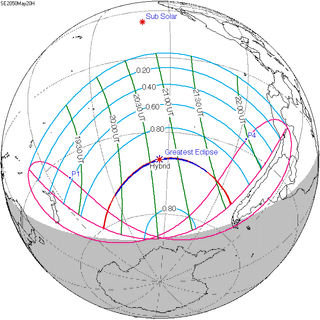| Solar eclipse of May 20, 2050 | |
|---|---|
| Type of eclipse | |
| Nature | Hybrid |
| Gamma | −0.8688 |
| Magnitude | 1.0038 |
| Maximum eclipse | |
| Duration | 21 s (0 min 21 s) |
| Coordinates | 40°06′S 123°42′W / 40.1°S 123.7°W |
| Max. width of band | 27 km (17 mi) |
| Times (UTC) | |
| Greatest eclipse | 20:42:50 |
| References | |
| Saros | 148 (23 of 75) |
| Catalog # (SE5000) | 9619 |
A total solar eclipse will occur at the Moon's descending node of orbit on Friday, May 20, 2050,[1] with a magnitude of 1.0038. It is a hybrid event, with only a fraction of its path as total, and longer sections at the start and end as an annular eclipse. A solar eclipse occurs when the Moon passes between Earth and the Sun, thereby totally or partly obscuring the image of the Sun for a viewer on Earth. A total solar eclipse occurs when the Moon's apparent diameter is larger than the Sun's, blocking all direct sunlight, turning day into darkness. Totality occurs in a narrow path across Earth's surface, with the partial solar eclipse visible over a surrounding region thousands of kilometres wide. Occurring about 5.2 days after perigee (on May 15, 2050, at 16:40 UTC), the Moon's apparent diameter will be larger.[2]
This hybrid eclipse is notable in that it does not hit land anywhere on Earth. However, a partial solar eclipse will be visible for parts of New Zealand, eastern Oceania, and western South America.
- ^ "May 20, 2050 Total Solar Eclipse". timeanddate. Retrieved August 15, 2024.
- ^ "Moon Distances for London, United Kingdom, England". timeanddate. Retrieved August 15, 2024.
